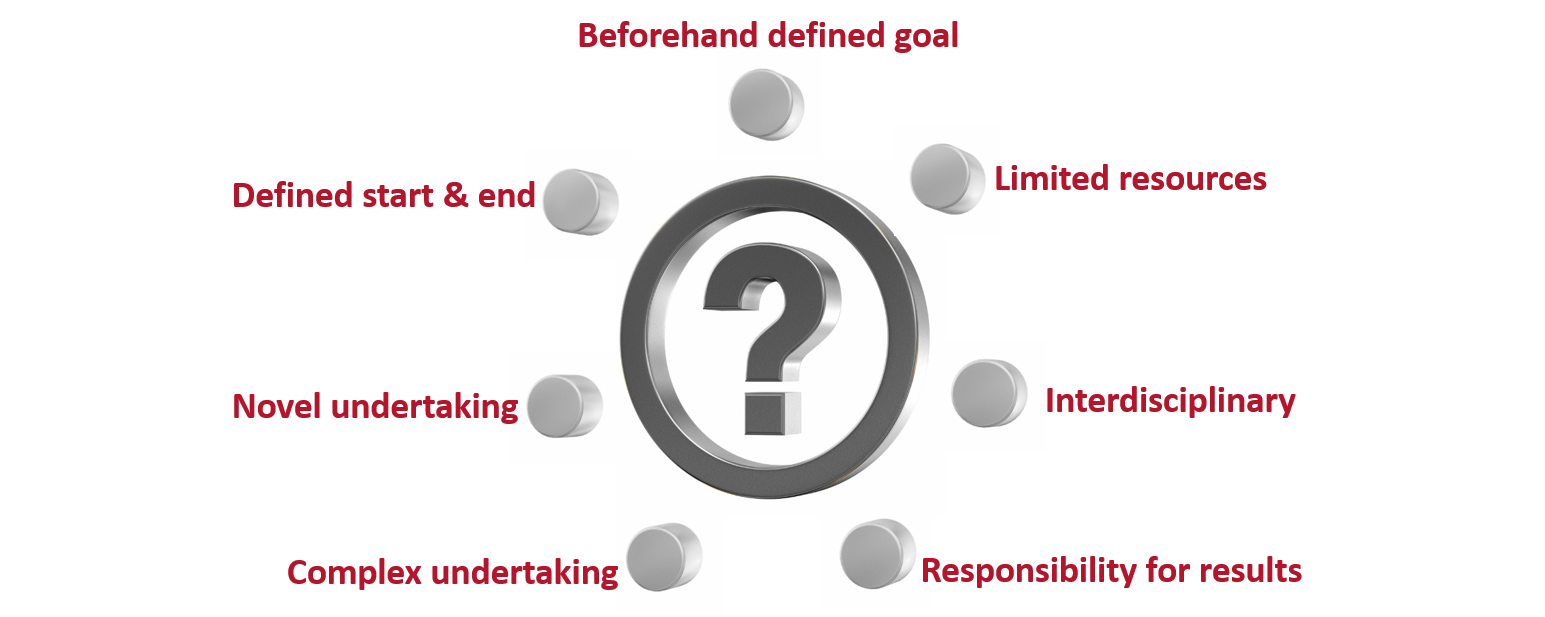Chapter 1 - Project Check¶
Part 2¶
How is a project characterised? - Make the project check!¶
In order to be classified as a project, these seven criteria need to apply to your task.

Only if all mentioned characteristics can be answered with "yes", your undertaking is truly a project. In fact, you cannot only answer these questions simply by checking if the criteria are fulfilled, but you need to define real answers!
Remember
Every task that isn't a project, is a routine activity. But within every project routine tasks are inevitable.
Here are some examples, that may be useful dealing with that topic:
| Project characteristics | Examples |
|---|---|
| Objective definition before work commences | Given goals |
| Limited resources | Defined budget Team members' work capacity |
| Interdisciplinarity | Team from different departments |
| Defined start and finish | Given period of time |
| Defined responsibilities | Leader needed Assigned tasks |
| Novel undertaking | Something new is created Uniqueness in the conditions |
| Complex undertaking | Risks Many variables |
Classification of projects¶
Now, that you can differentiate between a project and a routine task by running a project check, it's time to talk about the various project types.
Every project in its entirety is unique, but you can classify them by assigning a project to (at least) one of these categories:
- Investment project (fixed assets are built or produced)
- Organisational project (structures for managing development and processes are created or changed and thereby improved)
- Research and development project (acquisition of new knowledge/skills or improvement of the product)
Independent from the type, projects can be classified as
- internal projects or
- external projects.
If the project owner is from outside the company, it is called external project. Whereas internal projects are characterised by a client or sponsor from inside the company.
Tasks in project management¶
In general, project management is the expertise in and the application of methods and management tools to ensure a projects' success, to reduce costs and to deal with time properly. There are some fundamentals you need to consider:
- From the start to the finish, a project has to be planned and executed - in between decisions have to be made.
- But also the best project manager can't plan a project without any target requirements, so those have to be defined before you can start planning.
- To check, if you're still on route, it is important to control the project's progress constantly.
Project management approaches and organisation¶
In general, there are many models how a project can be planned and realised. To mention the most common ones, here is a short overview:
| Model | Definition |
|---|---|
| Traditional project management | Established methodology, where projects are run in a sequential cycle It follows a fixed sequence Requirements are defined at the beginning |
| Agile project management | Highly iterative, focused on self-coordination The project manager approves consecutive versions of sub-projects at short intervals to obtain fast and regular feedback from users Most common in software development |
| Waterfall model | The phases in the waterfall model are implemented in sequence Documentation is performed at the end of every phase (document-driven) Phase backtracking (to remedy defects) is only possible between adjacent phases |
| V-model | Suitable for large-scale software projects Extension of the waterfall model Originally used in software planning projects |
Not only the project management model influences project planning, but the project organisation of a company as well. They outline the relationship between the various participants, the lines of responsibility, the lines of authority and the lines of communication. The project can either be organised as
- functional (unit) project organisation,
- pure (= autonomous) project organisation or
- matrix organisation.
Depending on the project organisation, the project manager has different control over the project and his team.
Functional organisation
Groups people by specialisation such as production, marketing, engineering, etc.. It is easier to manage specialists if they are grouped together and supervised by an individual with similar skills and experiences.
Pure project organisation
Has as autonomy from the rest of the company a self‐contained unit with its own technical staff and project office. It is similar in shape to the functional organisation structure except that all the departments are dedicated to the project.
Matrix organisation
Relies on the functional departments for resources. The project manager won't have much authority on his team members as they report to their functional managers and are not only dedicated to one project, but to many different ones.
How the story ends…¶
After some reflection time, Dr. Rogers was able to work out some points underpinning that the given task is a project. Since the instruction comes from his line manager, it is definitely an internal project. But still, he isn't quite sure which type of project he's dealing with.
The project probably won't restructure the company's internal organisation, nor will new assets be built. After excluding the other project types - investment and organisational project - the only reasonable type left is the research and development project. Following common sense, this is only logical for developing a new hay fever medication, he thinks.